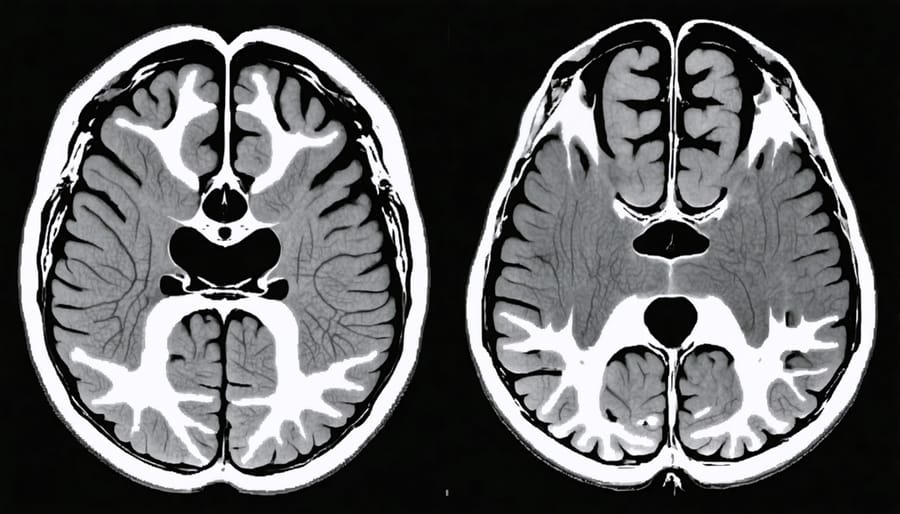Intergenerational trauma is a painful reality that echoes through generations, shaping the lives and mental health of countless children. The wounds inflicted by childhood trauma, abuse, neglect, and family dysfunction are not confined to the immediate victims; they ripple outwards, impacting the emotional wellbeing of future generations in profound and often unrecognized ways. As we strive to create a more compassionate and nurturing world for our children, it is crucial that we confront the stark truth of intergenerational trauma head-on, armed with understanding, empathy, and a unwavering commitment to breaking the cycle of suffering.
The Science Behind Intergenerational Trauma
Epigenetics and Trauma Transmission
Recent research has revealed that trauma can be passed down through generations, not just through learned behaviors or family dynamics, but via epigenetic changes. Epigenetics refers to modifications in gene expression that don’t involve changes to the DNA sequence itself. When a person experiences severe trauma, it can lead to epigenetic alterations that affect how their genes are expressed. These changes can then be passed on to their children and even grandchildren.
Studies have shown that children of Holocaust survivors, for example, have altered stress hormone profiles compared to their peers, even if they never directly experienced the trauma. Similar findings have been observed in the offspring of survivors of other traumatic events, such as the 9/11 attacks and the Rwandan genocide. This suggests that the impact of trauma can extend beyond the individual who directly experienced it, leaving a lasting imprint on future generations.
While the exact mechanisms of epigenetic trauma transmission are still being researched, it’s clear that the effects can be profound. By understanding how trauma can be passed down through generations, we can develop more effective strategies for preventing and healing intergenerational trauma, breaking the cycle of suffering and promoting resilience in families and communities.

Neurobiological Effects on Children
Intergenerational trauma can have profound effects on a child’s developing brain. When parents or caregivers have experienced traumatic events, their emotional responses and coping mechanisms can inadvertently impact their children’s neurobiological development. Children exposed to chronic stress and trauma may experience changes in brain structure and function, particularly in areas related to emotion regulation, memory, and learning.
Studies have shown that children of traumatized parents may have altered levels of stress hormones, such as cortisol, which can affect brain development. They may also have increased activity in the amygdala, a brain region involved in processing fear and emotional responses. Additionally, the prefrontal cortex, which plays a crucial role in decision-making, impulse control, and emotional regulation, may be less developed in children exposed to intergenerational trauma.
These neurobiological changes can manifest as emotional and behavioral challenges, such as anxiety, depression, difficulty with attachment, and heightened stress responses. Children may struggle with self-regulation, attention, and learning, which can impact their academic performance and social relationships.
However, it’s important to note that the brain is remarkably adaptable, and with the right support and interventions, children can build resilience and overcome the effects of intergenerational trauma. Nurturing relationships, a stable environment, and access to mental health resources can help promote healthy brain development and emotional well-being.


Recognizing Intergenerational Trauma in Children
Emotional and Behavioral Indicators
Children struggling with intergenerational trauma may exhibit various emotional and behavioral indicators, including:
1. Anxiety and fear: Children may experience excessive worry, nervousness, or fear in response to seemingly minor triggers or without apparent cause.
2. Mood swings and irritability: Rapid changes in mood, frequent outbursts of anger, or a generally irritable disposition can be signs of underlying trauma.
3. Difficulty regulating emotions: Children may struggle to manage their emotions, leading to intense reactions or an inability to self-soothe.
4. Withdrawal and isolation: Some children may retreat from social interactions, avoid activities they once enjoyed, or appear emotionally distant.
5. Difficulty forming attachments: Intergenerational trauma can impact a child’s ability to form secure, trusting relationships with caregivers and peers.
6. Sleep disturbances: Nightmares, insomnia, or frequent waking can be indicators of unresolved trauma.
7. Physical complaints: Children may experience unexplained stomachaches, headaches, or other physical symptoms related to emotional distress.
8. Hypervigilance: Some children may be constantly on alert, easily startled, or display a heightened sensitivity to their surroundings.
9. Reenactment of traumatic experiences: Children may engage in play or behaviors that mirror the traumatic events experienced by their family members.
10. Difficulty concentrating: Trauma can impact a child’s ability to focus, leading to academic challenges or inattention.
Recognizing these indicators is crucial for providing timely support and intervention. By understanding the signs of intergenerational trauma, parents, educators, and healthcare professionals can work together to create a nurturing environment that promotes healing and resilience.
Case Studies and Real-Life Examples
Maria, a 10-year-old girl, struggles with anxiety and low self-esteem. Her mother experienced abuse as a child and often lashes out in anger. Through therapy, they’re learning to break the cycle of trauma. Jason, 7, has difficulty regulating his emotions. His father, a war veteran with PTSD, is emotionally distant. Play therapy is helping Jason express himself and strengthen their bond. Sarah, 15, battles depression and self-harm. Her grandmother survived the Holocaust but never dealt with her trauma, passing down a legacy of pain. Family counseling is helping them heal and build resilience. These stories illustrate how unresolved trauma can impact generations, but also offer hope for breaking free from the past and creating a brighter future. With support and intervention, families can overcome the struggles with intergenerational trauma and foster a healthier, more connected future for their children.
Breaking the Cycle: Healing and Prevention Strategies
Therapy and Counseling Approaches
There are several therapeutic approaches that can help children and families heal from intergenerational trauma. Trauma-focused cognitive behavioral therapy (TF-CBT) is an evidence-based treatment that helps children process traumatic experiences, develop coping skills, and improve family communication. Another effective approach is attachment-based family therapy, which focuses on strengthening the parent-child bond and creating a safe, nurturing environment for healing. Mindfulness-based interventions, such as mindfulness-based stress reduction (MBSR), can also be beneficial in reducing anxiety, promoting emotional regulation, and fostering resilience. For parents, seeking individual therapy to address their own trauma history can be crucial in breaking the cycle of intergenerational trauma. Family therapy sessions provide a space for open communication, problem-solving, and building a shared understanding of the impact of trauma. It’s important to work with mental health professionals who have experience in treating trauma and can create a safe, non-judgmental space for healing. With the right support and interventions, children and families can overcome the effects of intergenerational trauma and build a foundation for a healthier future.
Building Resilience and Coping Skills
Fostering resilience and healthy coping skills in children is crucial for breaking the cycle of intergenerational trauma. One of the most important steps is to create a safe, nurturing environment where children feel loved, supported, and heard. Encourage open communication and validate their feelings, allowing them to express their emotions without fear of judgment or punishment.
Engaging children in activities that promote self-expression, such as art, music, or journaling, can help them process their emotions and develop a stronger sense of self. Encourage them to identify and pursue their passions, as this can boost self-esteem and provide a healthy outlet for stress.
Teaching children stress-management techniques, such as deep breathing, mindfulness, or yoga, can equip them with tools to navigate challenging emotions and situations. Modeling these techniques yourself and practicing them together can reinforce their importance and effectiveness.
Emphasize the value of social connections and encourage children to build supportive relationships with friends, family, and mentors. These relationships can provide a sense of belonging, offer guidance, and serve as a source of strength during difficult times.
Finally, seek professional help when needed. Therapists specializing in childhood trauma can provide targeted support and guidance for both children and their caregivers, helping to break the cycle of intergenerational trauma and promote healing.
The Role of Supportive Environments
Creating safe, nurturing environments is crucial for helping children heal from intergenerational trauma and thrive. When children feel secure, loved, and supported, they are better equipped to process their emotions, develop resilience, and break the cycle of trauma. Parents, caregivers, and educators play a vital role in fostering these supportive spaces.
At home, creating a stable, predictable routine can help children feel secure. Engaging in positive, nurturing interactions, such as reading together, playing, and having open, honest conversations, strengthens the parent-child bond and promotes emotional well-being. Consistently responding to a child’s needs with empathy and understanding helps them feel valued and heard.
In schools, trauma-informed practices can create a supportive learning environment. This includes training teachers to recognize signs of trauma, implementing positive behavior support strategies, and offering mental health resources. By creating a safe, inclusive classroom atmosphere where all students feel respected and supported, educators can help children build resilience and develop healthy coping mechanisms.
Healthcare professionals can also contribute to supportive environments by providing trauma-informed care. This involves screening for trauma, offering evidence-based treatments, and collaborating with families to develop personalized care plans. By approaching patient care with empathy, sensitivity, and a focus on healing, healthcare providers can help children and families navigate the challenges of intergenerational trauma and work towards a brighter future.
Conclusion
The evidence presented in this article confirms that intergenerational trauma is a real and significant phenomenon. It can have a profound impact on the mental health and well-being of individuals across generations. Children who grow up with parents or caregivers who have experienced trauma may be more vulnerable to developing mental health challenges, even if they have not directly experienced the traumatic events themselves.
However, it is essential to recognize that healing is possible. By understanding the roots of intergenerational trauma and its potential effects, we can take steps to break the cycle and promote resilience in ourselves and our children. This may involve seeking professional support, such as therapy or counseling, to process and heal from past traumas. It may also involve developing healthy coping mechanisms, building strong support networks, and fostering open and honest communication within families.
As parents, teachers, and healthcare professionals, we have a crucial role to play in supporting children who may be affected by intergenerational trauma. By creating safe and nurturing environments, promoting mental health literacy, and seeking support when needed, we can help children develop the skills and resilience they need to thrive. Together, we can work towards a future where the impact of intergenerational trauma is minimized, and where all children have the opportunity to lead healthy, happy lives.







